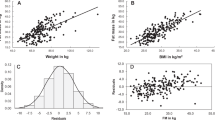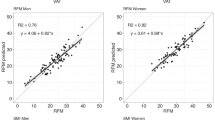Abstract
OBJECTIVE: To examine the extent to which extent health-related anthropometric characteristics such as body mass index, waist–hip ratio, waist girth, percentage of body fat and weight gain are associated with physical activity and nutritional habits in a prospective follow-up study.
DESIGN: A 5-y prospective follow-up study.
SUBJECTS: 132 healthy men from The Leuven Longitudinal Study on Lifestyle, Physical Fitness, and Health.
MEASUREMENTS: The main outcome measures in this study were body mass index, waist–hip ratio, waist girth, percentage of body fat and significant weight gain at the ages of 35 and 40 y. An unhealthy body composition was defined as a body mass index above 26, a waist–hip ratio above 0.95, a waist girth and body fat percentage above percentile 75 at the end of the 5-y follow-up period and a significant weight gain of 5 kg or more between the two examination periods. Anthropometric characteristics were derived from clinical examination. Physical activity at the age of 35 and 40 and nutritional habits at the age of 40 were determined from questionnaires.
RESULTS: Physical activity was the most important predictor for the waist–hip ratio in this sample. In contrast, nutritional habits show a stronger relationship with body mass index. The absolute amount of energy intake is not as important as the dietary factors in predicting subjects with overweight or an unhealthy body composition. The index of occupational activities appears to be the most important physical activity variable.
CONCLUSION: The relative contribution of physical activity and nutritional habits in health-related anthropometry varies with the characteristic considered. It is important to include all components of physical activity, and occupational activities in particular, in determining these relationships in a general population sample.
This is a preview of subscription content, access via your institution
Access options
Subscribe to this journal
Receive 12 print issues and online access
$259.00 per year
only $21.58 per issue
Buy this article
- Purchase on SpringerLink
- Instant access to full article PDF
Prices may be subject to local taxes which are calculated during checkout
Similar content being viewed by others
Author information
Authors and Affiliations
Corresponding author
Rights and permissions
About this article
Cite this article
Delvaux, K., Lysens, R., Philippaerts, R. et al. Associations between physical activity, nutritional practices and health-related anthropometry in Flemish males: a 5-year follow-up study. Int J Obes 23, 1233–1241 (1999). https://doi.org/10.1038/sj.ijo.0801052
Received:
Revised:
Accepted:
Published:
Issue date:
DOI: https://doi.org/10.1038/sj.ijo.0801052
Keywords
This article is cited by
-
Dietary factors associated with obesity indicators and level of sports participation in Flemish adults: a cross-sectional study
Nutrition Journal (2007)
-
Leisure-time physical activity and regular walking or cycling to work are associated with adiposity and 5 y weight gain in middle-aged men: the PRIME Study
International Journal of Obesity (2001)



